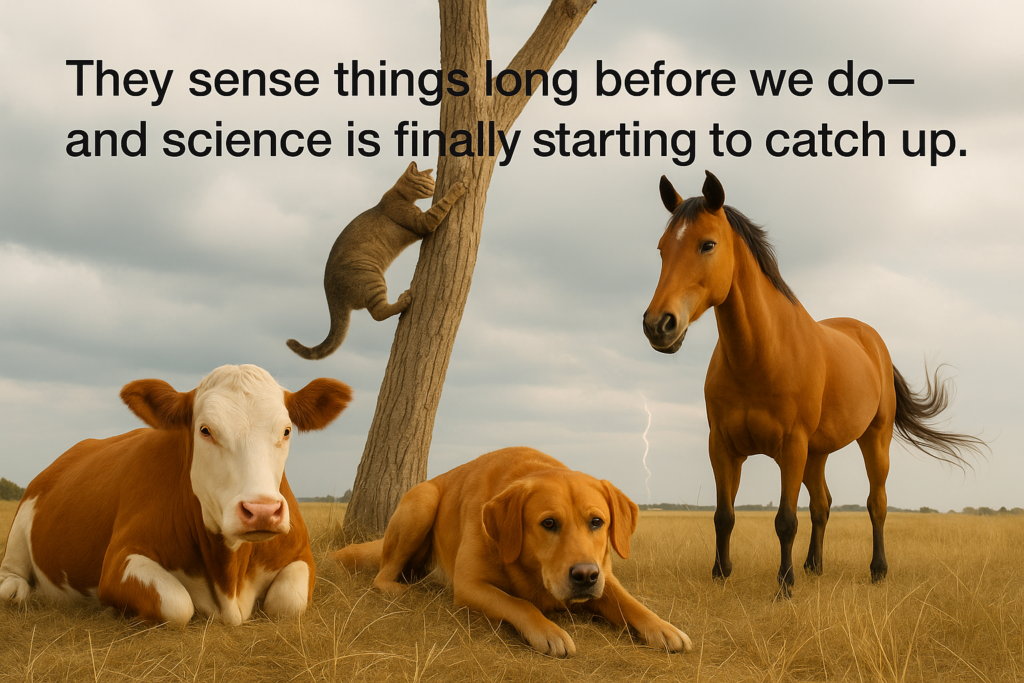
We like to think of weather warnings as the domain of satellites and radar. But long before we had apps buzzing about incoming storms, animals were already responding silently, instinctively, and often far more accurately than humans. Birds vanish, frogs chorus, and cats bolt from windowsills. Farmers have long trusted these shifts, and now science is beginning to explain why.
It turns out animals are extraordinary environmental sensors. Many detect subtle atmospheric changes in barometric pressure, shifts in humidity, and even the low-frequency rumbles we can’t hear that precede thunder and earthquakes. Some researchers believe watching animals could become part of future early warning systems. Here’s what to look for, and why these behaviors may matter more than ever.
1. Birds Disappear From the Sky
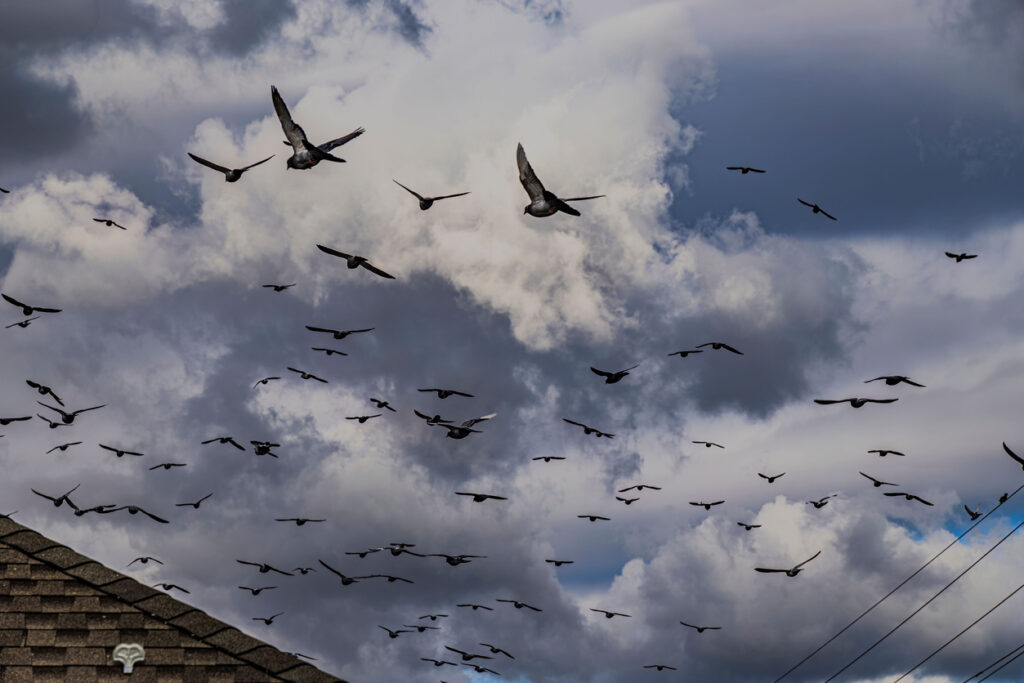
In the hours before a significant storm, birds often vanish into thin air. They stop singing, leave feeders untouched, and disappear from open skies and tree branches. During Hurricane Irma in 2017, radar technicians noticed something eerie: flocks of birds that had previously filled the skies over Florida were gone. Even species like pigeons and sparrows, which usually thrive in noisy, urban environments, went completely silent. Researchers confirmed that birds evacuated the area long before wind or rain arrived. Their sudden absence created noticeable gaps on Doppler radar, typically used to track precipitation, not wildlife.
Birds have long been known to detect barometric pressure changes, often hours before any sign of a storm. A rapid drop in pressure signals dangerous flying conditions: strong winds, shifting thermals, and disorienting gusts. Some species, like swallows and swifts, may even migrate away from incoming storm paths, traveling hundreds of miles to avoid turbulence. Others hunker down in dense trees or low-lying shrubs, conserving energy until the weather clears. Folklore and farming communities have watched these behaviors for generations. When the skies go still, something’s coming. Now, scientists are using weather radar and satellite tracking to monitor bird movement as part of real-time storm prediction models. Source: Smithsonian Magazine
2. Dogs Whine, Hide, or Suddenly Act “Off”

Your dog might already be reacting long before you hear thunder or see clouds gathering. Many pet owners report their dogs becoming anxious, vocal, or unusually clingy hours before a storm begins. Some dogs retreat to small, enclosed spaces—under beds, in closets, or behind couches, while others pace the house or bark at seemingly nothing. These aren’t quirks. Their responses are rooted in canine biology. Dogs can detect distant thunder that registers at frequencies below our hearing range, sometimes more than 20 miles away. They may also sense subtle shifts in air pressure, humidity, and electrical charge that most humans miss entirely. According to veterinary behavior studies, some dogs begin acting strangely up to 60 minutes before a storm hits.
Their sensitivity doesn’t stop with hearing. Dogs have a remarkable ability to pick up on environmental cues through their noses and paws. They may detect ozone the sharp, slightly metallic scent that often accompanies approaching lightning or feel static electricity building in the air through their fur. Some researchers believe dogs may even detect vibrations through the ground, similar to how they respond to distant fireworks or earthquakes. Certain breeds, like herding or working dogs, are particularly tuned in due to their historical roles in outdoor environments. While not every dog reacts dramatically, when they do, it’s often worth paying attention. Their instincts, honed over generations of living close to the land and their humans, can provide valuable early warnings especially when our devices haven’t caught up yet. Source: The Weather Channel
3. Cats Flee to High Ground or Hunker Down

Cats are famous for their aloofness, but their behavior often shifts dramatically when a storm is on the way. Some cats seek high ground, climbing bookshelves, perching on cabinets, or retreating to the top of closets, as if anticipating rising water or danger below. Others disappear into enclosed spaces: under furniture, bathroom cabinets, or behind appliances. These responses aren’t random. Cats are acutely sensitive to environmental changes, including barometric pressure drops and electromagnetic shifts that precede storms. Many owners have reported their cats behaving nervously, hiding, or becoming unusually quiet several hours before the weather turns. It’s the behavior you might only notice in hindsight, after the rain hits and you realize your cat already knew.
Research suggests cats may be able to detect infrasonic frequencies, low, rumbling vibrations produced by distant thunder or seismic activity that human ears can’t register. These sounds travel great distances through the ground and air, giving cats a sensory advantage when it comes to anticipating natural disasters. During the 2004 Indian Ocean tsunami, there were reports of cats fleeing coastal areas for higher ground minutes before the waves struck, reinforcing the idea that feline instincts are tuned to more than just curiosity. Some experts believe cats can even feel shifts in static electricity on their whiskers or fur before lightning begins. Whether they run, freeze, or climb, their reactions are often subtle but telling. If your cat vanishes before the sky changes, it might be less about hiding, and more about surviving. Source: BBC Earth
4. Frogs and Toads Start Singing—Loudly

While many animals grow quiet before a storm, frogs do the opposite. In the hours before a downpour, certain frog and toad species break into a loud, almost frantic chorus of croaks and trills, sometimes in broad daylight. It’s not just noise. It’s a biological alarm clock tied to survival. Frogs rely on water to reproduce, and storms create ideal short-lived habitats like puddles, ditches, and temporary ponds. When the humidity rises and barometric pressure drops, frogs sense their brief window to find a mate and lay eggs. Their singing is both a signal to potential partners and a natural forecast of impending rain. Studies have shown that some frog species can detect atmospheric changes up to 24 hours in advance, triggering their calls well before we see a cloud.
The behavior varies by region and species. In the southern United States, for example, tree frogs are known to sing from rooftops and windowsills just before thunderstorms roll in. In tropical zones, rain frogs and toads time their entire breeding cycles around monsoon activity. Scientists believe frogs might also sense infrasonic vibrations subtle ground tremors and low-frequency noises that accompany distant thunder or shifting weather systems. These cues help them prepare not just for rain, but for potential floods or changing habitat conditions. Indigenous communities across continents have long listened for frog calls as part of their natural weather forecasting toolkit. When frogs sing in unison before the rain, it’s not just about romance it’s a centuries-old system of storm prediction. Source: New Scientist
5. Insects Vanish, Swarm, or Go Dead Still
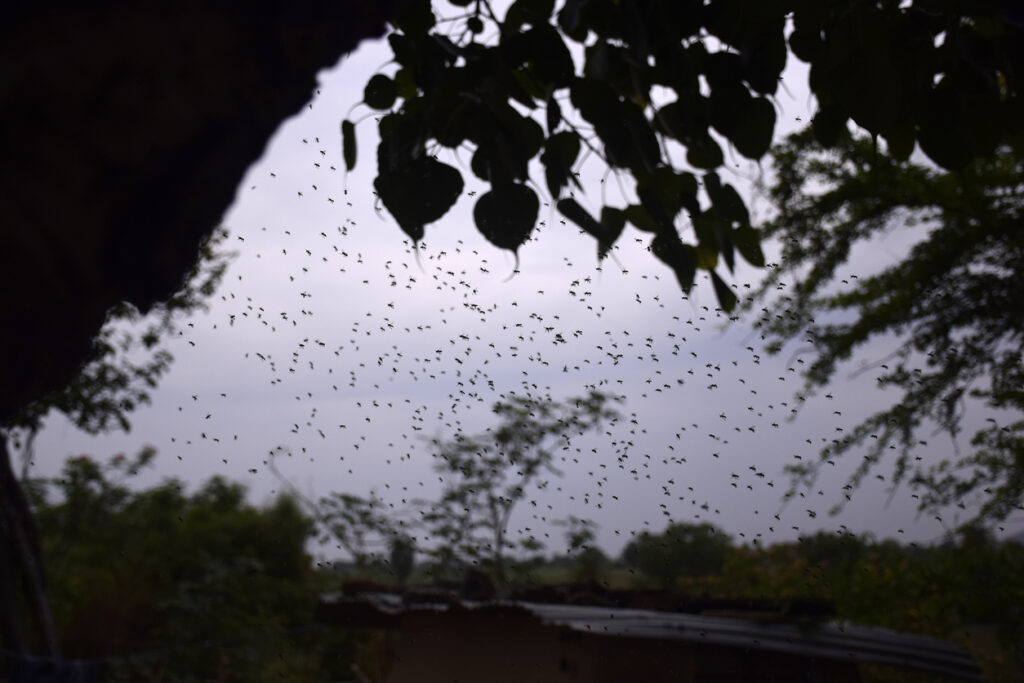
Insects are among the most responsive creatures to changing weather, and their behavior before a storm can range from eerie silence to chaotic swarming. One of the first signs that a storm is brewing is often a sudden drop in insect activity no bees on flowers, no dragonflies skimming ponds, no cricket songs at dusk. This stillness isn’t coincidental. Many insects detect drops in barometric pressure, rapid shifts in humidity, and changes in air conductivity caused by impending thunderstorms. Bees, for example, will abruptly return to the hive hours before rainfall begins, sometimes in synchronized waves. Mosquitoes, on the other hand, stop flying entirely, sensing that turbulent wind and heavy air make for poor hunting conditions.
Other species respond in the opposite way by rising en masse. Ants may swarm the surface to reinforce their tunnels, while some species of flies and gnats form large clouds that move erratically across fields and sidewalks. Locusts and termites have even been known to emerge in greater numbers before a storm, driven by moisture in the air and a last-minute biological urge to reproduce or relocate. Scientists have begun studying insect reactions as potential indicators for short-term forecasting, especially in rural or agricultural regions. In Japan and parts of Southeast Asia, traditional farmers still use insect behavior to time planting and harvesting around storm seasons. When your backyard suddenly buzzes to life or falls completely silent it might not be random at all. It’s nature recalibrating in real time. Source: Science.org
6. Cows Lie Down—Sometimes

The old saying goes, “If the cows are lying down, it will rain.” While it might sound like farmyard folklore, there’s a surprising amount of truth behind this rural wisdom. Cows are highly attuned to changes in barometric pressure and temperature. When a storm approaches, pressure drops, and the air becomes cooler and more humid conditions that can prompt cows to lie down. One theory suggests they do this to reserve a dry patch of grass to sit on once the rain starts. Others propose it’s a way to conserve body heat and energy as the environment becomes less stable. Farmers across generations have noted that a storm often follows when an entire herd suddenly rests.
Scientific research has offered mixed but intriguing results. A 2013 study from the University of Arizona used motion-sensing collars on dairy cows and found a statistically significant increase in lying behavior before rainfall. However, it’s not consistent across all regions or herds. Weather isn’t the only factor; diet, time of day, and herd behavior can also play a role. Still, many cattle ranchers rely on the “cow barometer” as a secondary check when planning weather-sensitive tasks like feeding, herding, or moving livestock. It’s also been incorporated into local lore in regions ranging from the American Midwest to rural England. While not a foolproof forecast, it might be time to grab an umbrella if you see cows dropping to the ground under a grey sky. Source: BBC Science Focus
7. Sharks Dive Deep

Sharks are already on the move long before a hurricane reaches the shoreline, diving deep below the ocean’s surface in one of the most dramatic pre-storm responses in the animal kingdom. Researchers first discovered this behavior during Hurricane Charley in 2004, when several tagged blacktip sharks off the coast of Florida abruptly left shallow coastal areas and dove more than 100 feet below the surface. They remained at those depths for hours, only returning days after the storm had passed. It wasn’t an isolated event. Studies from NOAA and the University of Miami have since confirmed that multiple shark species, including bonnetheads, tiger sharks, and hammerheads, routinely seek deeper waters when storms approach.
This response is believed to be triggered by sudden drops in barometric pressure, which sharks detect through their lateral line system, an array of fluid-filled sensory organs running along their bodies that help them perceive vibrations and pressure changes. As the ocean surface becomes unstable, sharks instinctively seek out calmer, more oxygen-rich layers of water below. This dive not only protects them from injury and displacement but may also serve as a warning system for scientists. Marine biologists are now monitoring tagged sharks to help track hurricane activity in near-real time. In places like the Gulf of Mexico and the Bahamas, this natural behavior could eventually contribute to earlier alerts and better storm modeling. When apex predators head for deeper water, it’s not just instinct, it’s intelligence honed over 400 million years of survival. Source: Hakai Magazine
8. Elephants Walk Away From Danger—Before It Arrives

Few animals have sparked more awe or scientific curiosity when predicting disaster than elephants. In 2004, hours before the devastating Indian Ocean tsunami struck, witnesses in Sri Lanka and Thailand reported elephants trumpeting, breaking their restraints, and fleeing inland. Some even carried children on their backs as they climbed hills and moved away from the shore. No one elephant perished in that tsunami, despite widespread destruction. The question that followed: how did they know?
Scientists believe elephants are capable of detecting infrasound, low-frequency seismic vibrations that travel through the earth long before the shaking or waves reach human-populated areas. These frequencies, which can be emitted by earthquakes, volcanic shifts, and even deep ocean tectonic movement, are inaudible to humans but well within the elephant’s sensory range. Studies have shown elephants can pick up these signals from over 100 miles away. Their massive feet, filled with vibration-sensitive cells and connected to resonant limb bones, act like built-in seismic receivers. In some cultures, elephants are viewed as sacred protectors, and their storm-escaping behavior has only strengthened that belief. Wildlife conservationists are now exploring the idea of using elephant movement data as part of early disaster detection systems in vulnerable parts of Asia and Africa. When these intelligent giants start walking especially when they move against their normal routines, it may be time to pay close attention to what the ground is trying to say. Source: National Geographic
9. Horses Pace or Refuse to Be Ridden

Horse owners have long trusted their animals’ instincts more than any weather report. Before a storm, horses often become restless, difficult to handle, or flat-out refuse to be ridden. In stables, they might paw at the ground, whinny more than usual, or attempt to escape their enclosures. Out in pasture, they may cluster together, turn their backs to the wind, or suddenly take off running—despite calm skies above. These behaviors aren’t just superstition. Horses, like dogs and elephants, are highly sensitive to shifts in barometric pressure and can pick up subtle vibrations in the ground long before humans notice anything is wrong.
Researchers believe horses may also detect static electricity in the atmosphere, especially through their manes and tails, which can become charged in the lead-up to lightning activity. That uncomfortable tingling could explain sudden spooks or refusal to approach open spaces. Some studies suggest horses become more reactive up to 12 hours before a major storm, especially in regions prone to lightning or tornados. In 2020, equine behaviorists in Australia began studying horse responses to barometric changes as a way to better prepare for bushfires and storms. Across cultures, horses have played vital roles in alerting communities to approaching danger. Native American tribes, Mongolian nomads, and European cavalrymen all trusted horse behavior as a form of early detection. If your horse stops at the gate, sidesteps the trail, or just won’t settle it might not be stubbornness. It might be survival. Source: The Horse Forum
10. Bats Stay in the Roost

Bats are among the most weather-sensitive mammals, and their behavior before a storm offers quiet but powerful clues. Normally active at dusk, bats often delay or entirely skip their evening flight when a storm approaches. In regions like the southern U.S., researchers have noticed entire colonies remain in their roosts even when temperatures and daylight conditions seem ideal. It’s not just a fluke. Bats rely heavily on echolocation for navigation and feeding, and changes in humidity, air pressure, and wind speed disrupt the acoustic clarity of their surroundings. Fewer flying insects and distorted echoes make hunting dangerous and inefficient for insectivorous bats.
Scientists have begun tracking bat behavior to explore its value in storm forecasting. A 2011 study in Texas found that bat activity plummeted the night before severe weather, with some species declining by as much as 80 percent in aerial surveys. Barometric pressure is believed to be the key trigger: when it drops sharply, bats remain still, conserving energy and avoiding the risk of being caught mid-flight during turbulent weather. Some bat species also appear to detect low-frequency vibrations, potentially alerting them to nearby thunder or tectonic shifts. In folklore, bats have long been considered harbingers sometimes of bad luck, but often of change. Today, scientists are looking at them through a more practical lens. If the skies are calm but the bats stay home, there may be a storm worth watching. Source: Bat Conservation International
11. Worms Surface in Masses
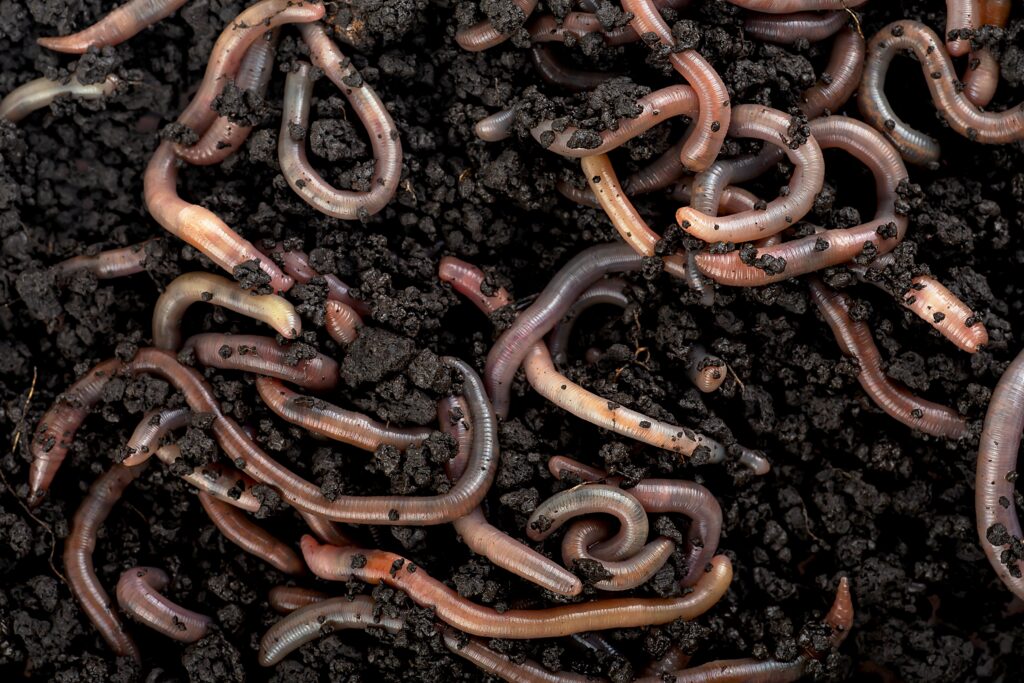
After a heavy rain, it’s common to see earthworms scattered across sidewalks and driveways, but some emerge before the first drop falls. In certain regions, especially during spring and summer storm seasons, worms rise to the surface in huge numbers in the hours leading up to a significant weather event. It’s a phenomenon that’s puzzled scientists and gardeners alike for decades. One prevailing theory is that worms sense barometric pressure drops and soil vibrations as a signal of impending saturation. Rather than risk drowning underground, they preemptively head for the surface where they can breathe freely, earthworms absorb oxygen through their skin and need moist but not flooded conditions to survive.
What’s remarkable is how early and coordinated this behavior can be. Researchers at the University of Wisconsin found that some earthworm species began surfacing up to 12 hours before measurable rainfall, suggesting an internal sensitivity to environmental cues. In other parts of the world, like Japan and India, farmers have used worm behavior as a natural planting calendar, when worms appear en masse, rain is likely within the day. There are also reports of worm “migrations,” where thousands move across the ground in coordinated patterns, possibly searching for new shelter before soil saturation becomes deadly. While the sight might be unsettling, it’s not random. These invertebrates are responding to tiny changes in pressure, moisture, and temperature that most of us overlook. When the worms flee early, it’s nature’s soft-spoken warning: get ready. Source: Scientific American
12. Fish Stop Feeding or Swim Erratically

Ask any seasoned angler, and they’ll tell you: the fish know when a storm is coming. Hours before a front moves in, fish often stop feeding altogether, vanish from the shallows, or begin swimming in strange, looping patterns. This isn’t just anecdotal, it’s well-documented in fresh and saltwater environments. Fish are highly sensitive to barometric pressure, which affects everything from buoyancy to metabolism. When the pressure drops, water becomes less dense, making it harder for fish to maintain their equilibrium. Many species, like bass and trout, respond by retreating to deeper, more stable zones, often becoming sluggish and uninterested in bait or movement near the surface.
Behavioral changes can also be linked to oxygen levels, which fluctuate before and during storms due to wind, rain, and temperature shifts. In coastal areas, saltwater fish like red drum and snook have been observed behaving erratically in the hours before hurricanes darting in circles, schooling tightly, or abandoning their usual feeding grounds. Fish also rely on their lateral line systems, specialized sense organs that detect vibrations and movement in the water to anticipate turbulence. This internal warning system helps them escape potentially fatal conditions. In aquariums, even domesticated fish like goldfish or tetras have been observed hiding in corners or sinking to the bottom when storms approach. Indigenous fishing cultures across the world have long used fish behavior to plan harvests or avoid danger. When the fish stop biting, or start acting strangely, it’s often nature’s way of saying the weather is about to turn. Source: Mercury Marine
13. Chickens Go Quiet and Roost Early
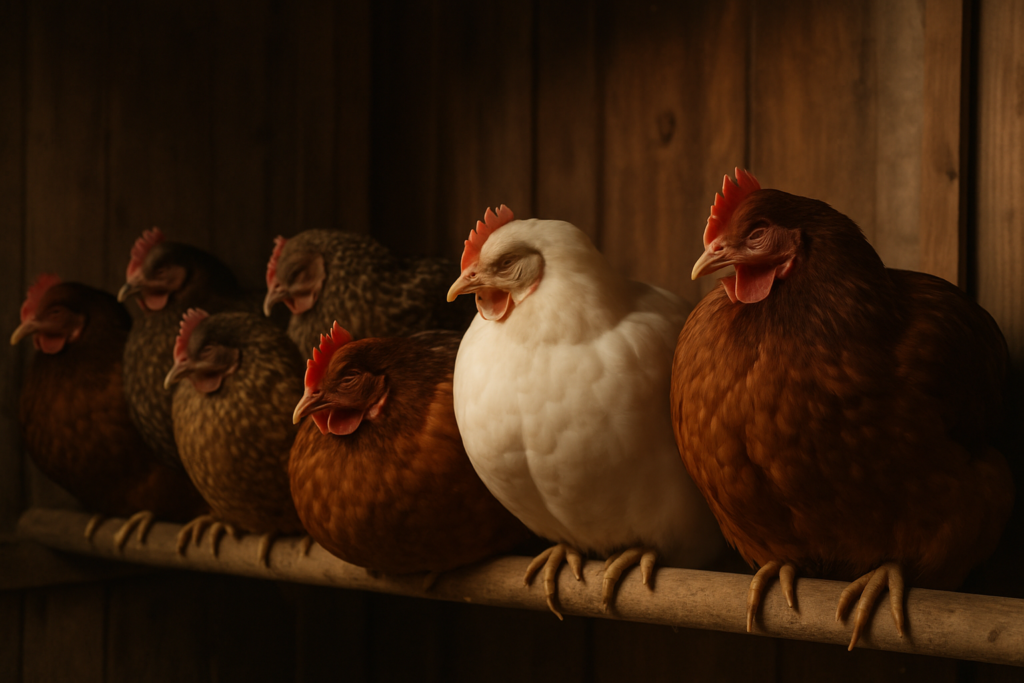
Long before radar alerts or weather apps chime, chickens often sense a storm and act accordingly. Backyard poultry owners frequently observe their hens going silent, clustering together, or heading into the coop much earlier than usual when bad weather is approaching. Normally active and vocal during daylight, chickens may stop scratching for food or abruptly hop onto roosts, sometimes hours before any visible sign of rain. It’s not a coincidence. Like many birds, chickens are sensitive to light changes, humidity, and barometric pressure. These environmental cues trigger instinctive sheltering behaviors rooted in survival. After all, a sudden storm can spell disaster for a ground-dwelling bird.
Research into avian meteorological sensitivity supports this anecdotal wisdom. A study from Mississippi State University found that domestic fowl adjust their behavior significantly when low-pressure systems are detected, often retreating earlier and laying fewer eggs. In traditional farm settings, generations of homesteaders watched their flock for signs of trouble. A silent henhouse in midafternoon was often taken as a sign that rain or worse was imminent. Some breeds are more sensitive than others; bantams and silkies, for instance, are known to be especially reactive to approaching weather. While chickens may not offer the drama of elephants or the mystery of sharks, their consistent, observable behavior makes them one of the most accessible natural barometers. If the flock disappears into the coop and things go strangely quiet, nature might be trying to tell you to take cover too. Source: Farmers Almanac
Why It Matters: When Instinct Becomes Early Warning

Long before our radar blips or weather apps chime, the natural world is already shifting. Animals respond not with panic, but with precision, sensing pressure drops, low-frequency tremors, electrical shifts, and vibrations that humans often overlook. From frogs that chorus before rain to elephants that flee inland before tsunamis, their behaviors are more than folklore; they’re field-tested, evolution-backed early warnings.
Science is finally catching up. Researchers are beginning to study these patterns not just as curiosities, but as tools. Satellite systems may lag, but a cat hiding under the bed or a sky empty of birds might be the first real sign something is coming. These creatures don’t just survive storms; they anticipate them. And if we learn to watch, listen, and believe them, they might help us stay one step ahead.
The story Strange Things Animals Do Before a Storm (and Why They Might Save You) was first published on DailyFetch.


